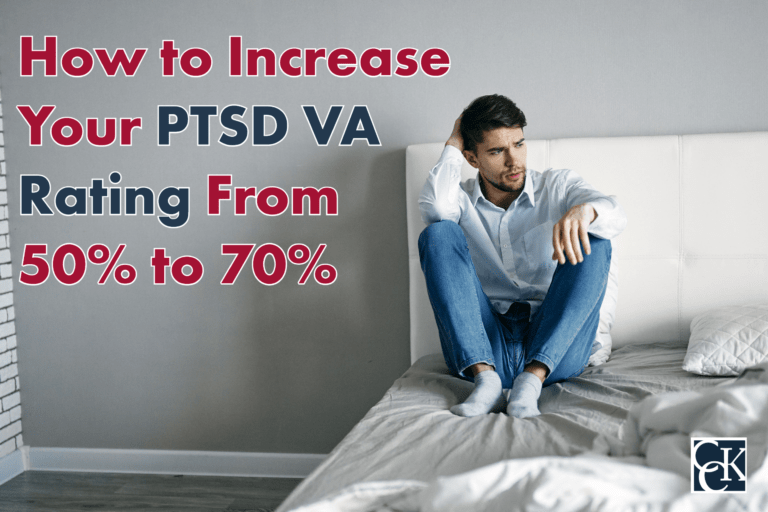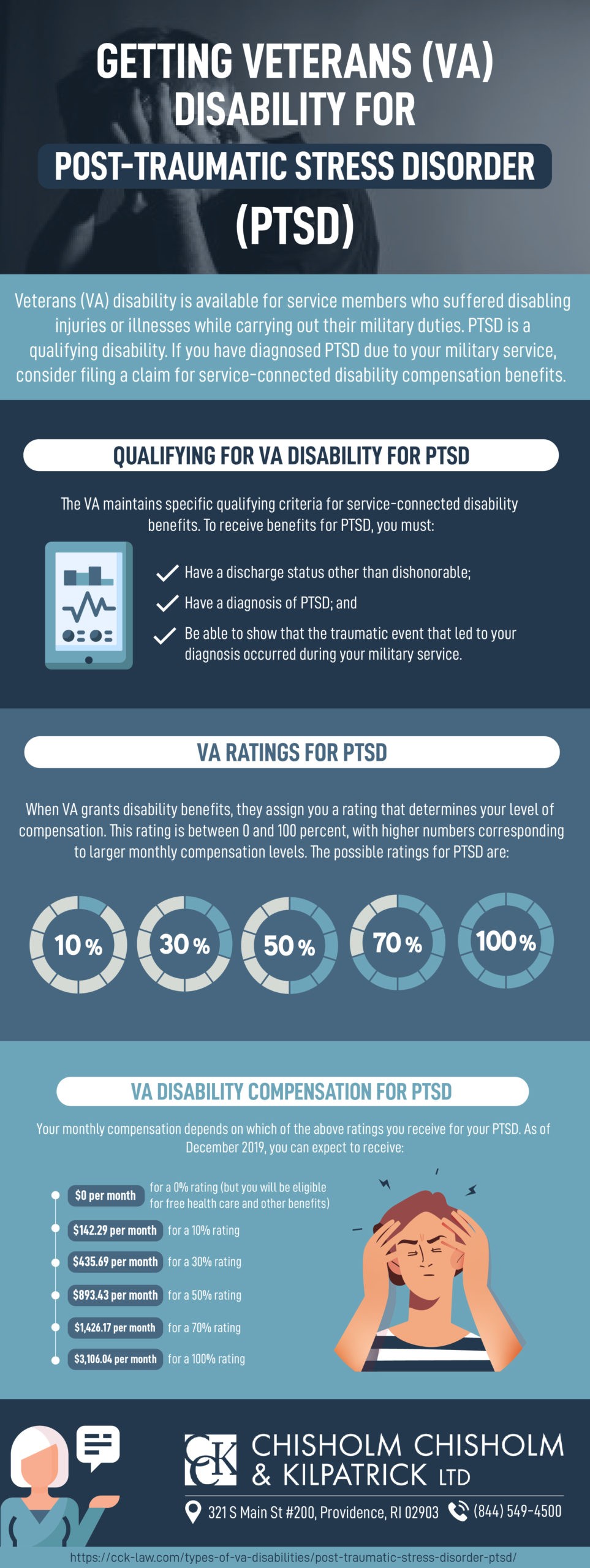How to Increase Your PTSD VA Rating From 50% to 70%

According to the U.S. Department of Veterans Affairs (VA), post-traumatic stress disorder (PTSD) is one of the most common conditions affecting the veteran community. VA offers disability compensation to veterans who develop PTSD due to their military service.
Sometimes, VA will assign veterans a disability rating that does not fully account for the severity of their PTSD. In this situation, the veteran has the option to request an increased rating.
If you are looking to secure a VA PTSD increase from 50 to 70 percent, there are a few key strategies to improve your chances.
What is PTSD?
Post-traumatic stress disorder (PTSD) is a mental health condition that occurs as a result of experiencing a distressing, shocking, or otherwise traumatic event. For veterans, this could be due to a natural disaster, an accident, a terrorist attack, war or combat, or any form of assault.
VA refers to these traumatic incidents as “stressors.” Veterans who experienced a stressor or multiple stressors during service and now have symptoms of PTSD may be eligible for VA disability benefits for PTSD.
PTSD Symptoms
PTSD symptoms do not always occur immediately after trauma – in some cases they can take years to manifest. Also, the symptoms and severity of PTSD can vary from person to person.
Some of the most common include:
- Re-experiencing the trauma through intrusive, distressing recollections of the event, flashbacks, and nightmares.
- Emotional numbness and avoidance of places, people, and activities that are reminders of the trauma.
- Increased arousal such as difficulty sleeping and concentrating, feeling jumpy, and being easily irritated and angered.

VA Rating Criteria for PTSD
With the exception of eating disorders, VA rates all mental health conditions under the same criteria. VA uses 38 CFR § 4.130, the General Rating Formula for Mental Disorders, to rate mental health conditions at 0, 10, 30, 50, 70, or 100 percent.
The criteria for each rating are as follows:
- 100 percent – Total occupational and social impairment, due to such symptoms as:
- Gross impairment in thought processes or communication; persistent delusions or hallucinations; grossly inappropriate behavior; persistent danger of hurting self or others; intermittent inability to perform activities of daily living (including maintenance of personal hygiene); disorientation to time or place; memory loss for names of close relatives, own occupation, or own name.
- 70 percent – Occupational and social impairment, with deficiencies in most areas, such as work, school, family relations, judgment, thinking, or mood, due to such symptoms as:
- Suicidal ideation; obsessional rituals which interfere with routine activities; speech intermittently illogical, obscure, or irrelevant; near-continuous panic or depression affecting the ability to function independently, appropriately and effectively; impaired impulse control; spatial disorientation; neglect of personal appearance and hygiene; difficulty in adapting to stressful circumstances (including work or a work-like setting); inability to establish and maintain effective relationships.
- 50 percent – Occupational and social impairment with reduced reliability and productivity due to such symptoms as:
- Flattened affect, circumstantial, circumlocutory, or stereotyped speech; panic attacks more than once a week; difficulty in understanding complex commands; impairment of short- and long-term memory; impaired judgment; impaired abstract thinking; disturbances of motivation and mood; difficulty in establishing and maintaining effective work and social relationships.
- 30 percent – Occupational and social impairment with occasional decrease in work efficiency and intermittent periods of inability to perform occupational tasks (although generally functioning satisfactorily, with routine behavior, self-care, and conversation normal), due to such symptoms as:
- Depressed mood, anxiety, suspiciousness, panic attacks (weekly or less often), chronic sleep impairment, mild memory loss (such as forgetting names, directions, recent events).
- 10 percent – occupational and social impairment due to mild or transient symptoms which decrease work efficiency and ability to perform occupational tasks only during periods of significant stress, or symptoms controlled by continuous medication.
- 0 percent – A mental condition has been formally diagnosed, but symptoms are not severe enough either to interfere with occupational and social functioning or to require continuous medication.
It is important to note that a veteran does not need to exhibit every symptom named in the PTSD rating scale to qualify for a specific rating. The symptoms listed under Diagnostic Code 9411 (PTSD) are not intended to constitute an exhaustive list, but rather serve as a framework for the type and degree of symptoms.
For example, a veteran who experiences suicidal ideation and near-continuous panic or depression but does not experience spatial disorientation or neglect of personal hygiene still falls under the 70 percent PTSD disability rating.
Filing for a Rating Increase for PTSD
In general, if a veteran believes their VA rating for PTSD is too low or if their symptoms have worsened since the initial rating decision, they can either file an appeal (if within one year of the date of the rating decision) or submit a new claim for an increased rating. Veterans also have the option to submit additional evidence to bolster their claim.

Tips to Secure a VA PTSD Increase from 50 to 70%
Highlight Specific Symptoms
Veterans looking for a VA PTSD increase from 50 to 70 percent should show they are experiencing symptoms at the severity of a 70 percent PTSD rating. While a veteran does not need to have every symptom listed to qualify, they should point out the relevant symptoms they are experiencing and how they are negatively affecting their daily life.
When writing a lay statement, a veteran should highlight their specific symptoms so VA can clearly see that they meet the 70 percent criteria for PTSD.
For example, if a veteran is experiencing near-continuous panic or depression, they should describe how it affects their relationships, their work, and their overall ability to function independently. These details can indicate that their PTSD warrants a 70 percent rating.
Use Lay Statements
As mentioned above, veterans can use lay statements to directly attest to the symptoms they experience on a regular basis, how severe those symptoms are, and how they may hinder their ability to function in social and occupational settings.
Statements from friends, family, or coworkers familiar with their situation can also help indicate the severity of the veteran’s symptoms.
Prepare for Your Compensation and Pension (C&P) Exam
When a veteran requests an increased rating for their post-traumatic stress disorder, VA will likely send them to another C&P exam that will focus mainly on the severity of the condition. Veterans should be honest and forthcoming about how PTSD affects their everyday life to ensure they receive an accurate rating.
It is essential to attend all scheduled C&P exams. VA may deny a veteran’s claim if they fail to attend a scheduled exam. If a veteran is unable to attend an exam, they should inform VA as soon as possible. If a veteran accidentally misses an exam, they should be sure to contact VA to try to reschedule.

File for Secondary Service Connection
If a veteran has a condition they believe was caused or aggravated by their service-connected PTSD, they can file for secondary service connection.
Secondary service connection can help increase an overall combined rating. This may help veterans who are pursuing a VA PTSD increase from 50 to 70 percent or even higher.
Some examples of conditions secondary to PTSD include:
- Sleep Apnea
- Hypertension
- Gastroesophageal reflux disease (GERD)
- Irritable Bowel Syndrome (IBS)
- Migraines
- Erectile Dysfunction
Need Help with Your Appeal for a VA PTSD Increase from 50 to 70%?
Chisholm Chisholm & Kilpatrick LTD may be able to help you secure an increased rating for your PTSD. The team of expert veterans’ advocates at CCK have assisted many veterans with appeals for disability benefits, and we can put our experience and resources to work for you.
If you believe you deserve a higher rating for your PTSD, reach out to CCK today to schedule a free case review.
About the Author
Share this Post

